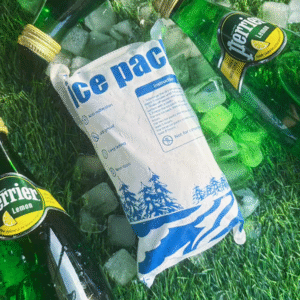Shipping temperature-sensitive goods, like food, pharmaceuticals, and biological samples, presents unique challenges, especially when these items must remain frozen or within a strict temperature range. In recent years, reusable dry ice packs have emerged as a key solution for cold chain logistics, offering both sustainability and cost-effectiveness. This article will explore why these packs are crucial, how they work, and the latest trends shaping the industry in 2025.
-
Why are reusable dry ice packs critical for shipping temperature-sensitive goods?
-
How do reusable dry ice packs work, and why are they ideal for long-term shipping?
-
What are the latest innovations and trends in reusable dry ice packs for 2025?
Why Are Reusable Dry Ice Packs Crucial for Shipping Temperature-Sensitive Goods?
Reusable dry ice packs are essential for shipping perishable items that need to remain cold for extended periods, such as food, pharmaceuticals, and vaccines. Unlike traditional gel or ice packs, dry ice packs use solid carbon dioxide (CO2), which sublimes directly into gas, keeping products cool without the risk of liquid mess. This ensures the integrity of sensitive items during transit, making them ideal for both short and long-distance shipments.
Advantages of Reusable Dry Ice Packs:
-
Extended Cooling Duration: Dry ice maintains a much lower temperature than traditional ice, with the ability to keep items cold for up to 72 hours.
-
Cost-Effectiveness: Reusable nature reduces the need for constant repurchase, making it a cost-effective solution in the long term.
-
Environmental Benefits: Reduces reliance on single-use cooling agents, helping businesses reduce plastic waste.
-
No Mess: As dry ice sublimates, there’s no liquid runoff to damage the products.
How Do Reusable Dry Ice Packs Work?
Dry ice packs use solid carbon dioxide to provide cooling. As CO2 sublimates directly from a solid to a gas, it absorbs heat from the environment, maintaining a stable low temperature around the product. This process is essential for shipping goods that require freezing conditions, like vaccines, frozen food, or certain biotech products.
Key Features of Dry Ice Packs:
-
Extreme Cold: Can reach temperatures as low as -78.5°C (-109.3°F).
-
No Melting: Unlike traditional ice packs, which melt and leave water, dry ice transitions into gas, avoiding moisture-related issues.
-
Durability: With proper care, these packs can be reused multiple times, further enhancing their cost-effectiveness.
| Feature | Dry Ice Packs | Traditional Ice Packs | Impact |
|---|---|---|---|
| Cooling Duration | 24 to 72 hours | 1-2 days | Longer cooling duration for long-distance shipments |
| Temperature Maintenance | -78.5°C (extremely low) | 0°C to 5°C | Ensures strict temperature control for sensitive goods |
| Reusability | Reusable | Single-use | Reduces waste and operational costs |
| Environmental Impact | Lower (reusable) | Higher (disposable) | Eco-friendly option for businesses |
How to Maximize Effectiveness:
-
Use Insulated Containers: To extend cooling duration, pair dry ice packs with high-quality insulated shipping containers.
-
Monitor Temperature: Use temperature sensors to track conditions throughout the transit.
Latest Innovations in Reusable Dry Ice Packs for 2025
The cold chain logistics sector is rapidly evolving. By 2025, new innovations in reusable dry ice packs are improving their efficiency, sustainability, and functionality.
Trends to Watch:
-
Smart Packaging Solutions: Real-time temperature monitoring is now possible thanks to IoT-enabled sensors in dry ice packs. These sensors allow businesses to track the conditions of their shipments at every step.
-
Sustainability Focus: As the demand for eco-friendly solutions grows, dry ice manufacturers are shifting towards biodegradable and recyclable materials for their packs, reducing environmental impact.
-
Customizable Solutions: Dry ice packs are now available in various shapes and sizes to suit specific needs, such as shipping fragile vaccines or large quantities of frozen food.
Smart Technology in Cold Chain Logistics:
-
Smart Sensors: Monitor and report temperature fluctuations during transit, ensuring sensitive items remain within required conditions.
-
Eco-Friendly Materials: As part of sustainability efforts, these packs are now often made from biodegradable and recyclable materials.
-
Custom Sizes & Shapes: Tailored solutions allow businesses to efficiently pack and protect different types of goods during shipment.
Practical Tips for Using Reusable Dry Ice Packs
To optimize shipping and maintain temperature stability, here are some best practices for using dry ice packs:
-
Pre-cool your packaging to prevent sudden temperature changes when the shipment is sealed.
-
Use the right amount of dry ice based on shipment duration and external temperatures to avoid overuse or underuse.
-
Consider destination climates: Warmer destinations may require additional insulation or dry ice to counteract the heat.
-
Monitor and adjust dry ice quantities for longer transit times to ensure that cooling is maintained.
Real-World Example: A pharmaceutical company successfully shipped temperature-sensitive vaccines using reusable dry ice packs with built-in smart sensors. Real-time monitoring ensured the vaccines were transported within the correct temperature range, leading to zero spoilage.
Future of Reusable Dry Ice Packs: What’s Next?
The future of reusable dry ice packs looks promising, with innovations focused on improving sustainability and shipping efficiency. In the coming years, we expect to see further advancements in materials and technologies that reduce carbon footprints and enhance temperature control.
Key Developments to Watch:
-
Carbon Footprint Reduction: Manufacturers are exploring ways to reduce the environmental impact of dry ice production, making the overall process more sustainable.
-
AI Integration: Artificial intelligence will optimize the use of dry ice, ensuring that shipments are packed with the ideal amount of cooling material, based on real-time data.
Frequently Asked Questions
What is the difference between reusable dry ice packs and traditional ice packs?
Dry ice packs maintain lower temperatures and are reusable, making them a better option for temperature-sensitive goods that require freezing conditions, unlike regular ice packs which may only keep things cool for a short period.
Can reusable dry ice packs be used for international shipments?
Yes, reusable dry ice packs are often used for international shipping. However, it’s essential to check regulations in the destination country as some may have specific rules about importing carbon dioxide.
How long do reusable dry ice packs maintain cold temperatures?
Depending on the insulation and the amount of dry ice used, these packs can keep items cold for up to 72 hours, making them suitable for both short and long-distance shipping.
Conclusion and Recommendations
Reusable dry ice packs are revolutionizing cold chain logistics by offering longer cooling durations, cost savings, and environmental benefits. As the cold chain industry continues to evolve, businesses should embrace these innovations to stay ahead of the competition.
Next Steps:
-
If you’re looking to improve your cold chain logistics, consider investing in reusable dry ice packs.
-
For more efficient shipping, opt for smart dry ice packaging solutions that offer real-time monitoring.
-
Ensure your shipping practices align with the latest sustainability and regulatory requirements by integrating reusable dry ice packs into your logistics strategy.
About Tempk
At Tempk, we specialize in providing advanced cold chain solutions, including high-quality reusable dry ice packs. Our products ensure the safe and efficient transport of temperature-sensitive goods while prioritizing sustainability. Reach out to us today to learn more about how our innovative solutions can optimize your shipping processes.
Call to Action:
Contact us today to discuss how Tempk’s dry ice solutions can enhance your cold chain logistics.
























